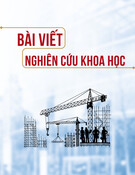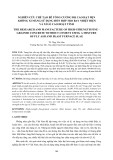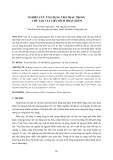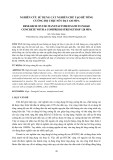
ISSN 1859-1531 - THE UNIVERSITY OF DANANG - JOURNAL OF SCIENCE AND TECHNOLOGY, VOL. 22, NO. 11B, 2024 109
RECENT APPROACHES FOR DEVELOPING A NOVEL GENERATION OF
BATTERIES USING CEMENT-BASED MATERIALS
Mai Thi Thu Thuy1, Nguyen Minh Hai1,2*, Nguyen Van Quang2, Nguyen Duc Tuan1,2,
Tran Dinh Minh1,2, Nguyen Duc Hung2
1AMAST Research Group, The University of Danang - Advanced Institute of Science and Technology, Vietnam
2The University of Danang - University of Science and Technology, Vietnam
*Corresponding author: nmhai@dut.udn.vn
(Received: July 14, 2024; Revised: October 04, 2024; Accepted: October 15, 2024)
DOI: 10.31130/ud-jst.2024.531E
Abstract - In the context of the increasing global demand for
sustainable energy development, the solution of using cement-
based materials to develop batteries for energy storage has
enormous potential, but this topic is still quite new to engineers and
scientists in the construction industry. This study aims to
systematically provide the basic principles as well as the current
approaches and technical challenges in the development of batteries
using cement-based materials. First, the paper presents the general
principles of conventional batteries and batteries based on cement-
based materials. Next, the paper discusses the main factors
affecting the performance of cement-based batteries based on
experimental results from previous studies. Finally, the paper
addresses the challenges and future research directions in this field.
The study hopes to help engineers in the construction industry
shape the scientific context, thereby providing appropriate
directions before developing products related to this novel field.
Key words - Concrete battery; cement-based material; energy
storage; electrode; electrolyte
1. Background
In the global context of moving towards sustainable
energy sources, the role of energy storage battery solutions
is extremely important [1]. The battery was first invented
in the 18th century by Alessandro Volta, using copper and
zinc electrodes in a salt solution to act as electrolytes [2].
Since then, there have been advances in creating batteries
with different combinations of materials for electrodes or
electrolytes including both liquid and solid to improve their
performance and durability of the battery [3, 4]. Nowadays,
these solutions play a key role in increasing the efficiency
of energy use, especially for renewable energy sources,
thereby contributing to reducing carbon emissions on a
global scale [5, 6].
On the other hand, cement-based materials, known by
other names such as mortar and concrete, are an extremely
popular material in the construction industry. This
popularity makes them one of the materials that occupies a
huge volume on the earth's surface because they are used
in most civil and infrastructure projects. Nowadays,
cement-based materials can be more broadly defined as
collections of discrete components bonded together by
cementitious adhesives. The discrete components used
today are very diverse, not only including traditional sand
and crushed stone aggregates but can include many other
components such as allotropes of carbon, metals or their
oxides, air bubbles, or other construction waste materials
[7, 8]. The abundance of these components makes them a
highly flexible material, creating many different smart
functions in addition to its main function of bearing
capacity. Recently, cement-based batteries have been
applied practically in the field of cathodic protection for
steel reinforcement in concrete structures, which helps to
prevent corrosion and extend the lifespan of these
structures [9]. In the future, it will be a big breakthrough if
this material is used in energy storage battery systems. This
will pave the way for the development of giant energy
storage systems, taking advantage of structures made of
cement-based materials in construction projects [10-12].
To develop a cementitious material that acts as an
electrolyte for batteries, the key lies in optimizing the
mixture composition and microstructure of the material to
help create a suitable ion transmission environment. This
involves the pore system within the cementitious material,
which helps create continuous ion transmission pathways
within the material. Besides, recent studies show that fillers
have high electrical conductivity and stability such as
carbon in different allotropes such as carbon black powder.
[13, 14], carbon nanotubes, carbon fibers, graphene [15] or
metal-based materials such as steel fibers, iron powder,
nickel, zinc, or their oxides [16] are considered as potential
fillers and can be used to optimize and adjust the ion
conduction, reducing the battery's resistance while still
ensuring the inherent mechanical properties of cement-
based materials. However, using the right amount and
method to help disperse these fillers to create a conductive
network inside the material is one of the major technical
challenges. In addition, battery performance also depends
on the type, size, and structure of the electrodes. However,
currently there are still not many documents, especially
domestic documents, that systematically overview the
general principles, analyze the factors affecting battery
performance as well as the technical challenges posed. In
the development of batteries using cement-based materials.
With the great significance and potential of this topic,
the purpose of this paper is to systematically provide basic
principles as well as current approaches and technical
challenges in cement-based battery development. Cement-
based materials to help engineers shape the context,
thereby providing appropriate directions before developing
products related to this new field. First, the paper presents
the general principles of conventional batteries and
batteries based on cement-based materials. Next, the paper

110 Mai Thi Thu Thuy, Nguyen Minh Hai, Nguyen Van Quang, Nguyen Duc Tuan, Tran Dinh Minh, Nguyen Duc Hung
presents the main influencing factors on battery
performance with cement-based materials based on
experimental results from previous studies. Finally, the
paper also addresses challenges and future research
directions in this field. This study is significant as it
systematically addresses the existing knowledge gaps and
provides a comprehensive overview of the principles,
technical challenges, and recent advancements in cement-
based battery development, thereby contributing to the
advancement of sustainable energy storage solutions.
2. Basics of batteries and batteries made of cement-
based materials
2.1. Principles of batteries
A battery is a device designed to store and provide
electrical energy. The basic structure of a battery includes
two electrodes: an anode and a cathode immersed in an
electrolyte, which can be in liquid, solid, or gel form. The
electrolyte acts as a medium for ion exchange between two
electrodes. In addition, a separation layer is needed that
prevents the flow of electrons and allows only ions to pass
through the electrolyte. This helps electrons to only move
when the two electrodes are connected to an external
circuit, allowing the battery to store energy when not
connected to the circuit.
Figure 1. Basic operating principle of the battery
Basically, the operation of a battery is based on the redox
(Reduction-Oxidation) reaction at the two electrodes, which
creates the flow of ions in the electrolyte and the flow of
electrons in the conductor when connected to an external
circuit. At the anode, the electrode material reacts with the
electrolyte to generate electrons, which accumulate at the
anode capable of donating electrons. Meanwhile, another
chemical reaction simultaneously occurs at the cathode,
making the electrode there capable of receiving electrons. The
direction of charge movement (electrons and ions) is opposite
in the two processes of charging and discharging, as described
in Figure 1. During the charging process, electrons move from
the cathode to the anode through the external circuit.
Concurrently, positive ions on the cathode material's surface
are released and move to the anode through the electrolyte. At
the anode, these positive ions meet electrons moving from the
external circuit, ensuring the charge-neutral state at the anode.
The discharging process is the opposite of charging. When the
battery is connected to an external circuit with a stimulating
voltage, electrons can move through the external circuit from
the anode to the cathode. This also allows the positive ions at
the anode to be released and move back to the cathode through
the electrolyte. The flow of electrons in the external circuit
generates current, and this redox process continuously occurs
to achieve charge balance at the anode. The discharging
process ends when the stored ions at the anode are depleted,
and the electron flow in the external circuit stops.
The materials commonly used to manufacture standard
batteries are presented in Table 1. The anode of the battery
is typically made of metal or various allotropes of carbon-
based materials due to their good electron exchange
capability, which facilitates the easy release and acceptance
of electrons during electrochemical processes. The cathode
of the battery is usually made of metal oxides with stable
structures and good ion acceptance capabilities, helping to
maintain electrochemical performance during charging and
discharging. Additionally, the electrodes need to operate at
high voltages with minimal heat generation, reducing energy
loss and ensuring safety during battery operation.
Table 1. Constituent materials of some types of batteries
Classification
Name Battery
Cathot
Anot
Electrolyte
Liquid-state
electrolytes
Lead-acid
PbO2
Pb
Sulfuric acid
Zinc-carbon
MnO2
Zn
Chloride salt
Nickel – metal
NiOOH
Zn or Fe
Alkaline
Silver oxide
Ag2O
Zn
Alkaline
MnO2
Zn
Mercury
HgO
Zn
Lithium-ion
LiCoO2
Graphite
Lithium salt
Solid-state
electrolytes
Lithium-Sulfur
Li
S
Sulfide
ceramics,
oxide
ceramics, or
ion-
conducting
polymers
Lithium-Silicon
Si
LiCoO₂
Lithium-Graphite
C
(Graphite)
LiFePO₄
Lithium-Cobalt
Oxide
Li
LiCoO₂
Lithium-Iron
Phosphate
Graphite
LiFePO₄
Lithium-Nickel
Manganese Cobalt
Oxide
Li or C
LiNMC oxide
Lithium-Titanate
Li₄Ti₅O₁₂
LiCoO₂
Sodium-Ion
Na
NaCoO₂
On the other hand, the electrolyte of the battery can exist
in liquid, solid, or gel form, but it must allow the movement
of charged ions. So far, the majority of battery electrolytes
exist in liquid form, usually alkaline, salt or acid solutions as
shown in Table 1, which have good ion conductivity between
cathode and anode. In recent years, batteries using solid
electrolytes, also known as solid-state batteries, have received
great attention from the scientific community. Common solid
electrolyte materials include ceramics such as sulfides, oxides,
and phosphates, as well as ion-conducting polymers. These
materials need not only to have high ionic conductivity but
also to have chemical and temperature stability so as not to
react with polar materials and not to decompose during
operation. This is especially important in applications such as
electric vehicles, where the battery must endure extreme
temperature conditions from the environment and the heat
generated during operation, to ensure safety and minimize the
risk of explosion, a common problem in batteries using liquid
electrolyte. In addition, the mechanical strength of the solid
electrolyte is an important factor to withstand pressure and
dimensional changes during charging and discharging, while
maintaining structure and ion transport performance. This is
an important key in developing energy storage solutions with
high performance and durability.

ISSN 1859-1531 - THE UNIVERSITY OF DANANG - JOURNAL OF SCIENCE AND TECHNOLOGY, VOL. 22, NO. 11B, 2024 111
(a) Ability to maintain voltage and oxygen concentration
(b) Relationship between voltage and water/cement ratio
Figure 2. Research results from Berstein and Speckert [17]
2.2. The battery using cement-based materials
With the general principle presented in Section 2.1,
batteries in which cement-based materials are used as
electrolytes, or even used for electrode materials are called
cement-based materials batteries, or it can be called
concrete battery. Wide-scale application of this battery
technology has the potential to create a breakthrough in the
energy industry, thanks to its ability to self-storage large
amounts of energy based on the pore volume of cement-
based materials such as concrete and mortar of buildings
and construction infrastructure.
The ion transmission capacity of cement-based materials
has been investigated by Berstein and Speckert [17]
discovered in a research in 2008. The cementitious material is
being used for the first time as an electrolyte in a battery
system with an anode made from aluminum and a cathode
made from iron, leading to the development of batteries made
from concrete-encased steel piles to provide power to offshore
structures. In this study, the basic principle of the electrolyte
is to rely on the pore system of concrete containing seawater
to act as an ion transmission environment between two
electrodes. The main results of the study are shown in Figure
2. Figure 2(a) shows the relationship between the voltage
between the two electrodes after charging the cement mortar
battery system as well as the oxygen concentration in the
material and the time obtained in the case of using a cement
mortar mixture with a water/cement ratio of 0.5 as the
electrolyte. The results show that cement mortar has the ability
to maintain voltage, but its performance is unstable and is
almost proportional to the Oxygen content in the concrete.
Besides, Figure 2(b) shows the relationship between the
water/cement ratio and the maximum voltage of the battery.
The results show that the maximum voltage is not
proportional to the water/cement ratio but there exists an
optimal value to achieve the highest voltage. This may be
related to the loss of charged ions to the surrounding
environment when increasing the mortar porosity to an
excessively high level. Therefore, the gradation design of the
cement mortar mixture is an important key to increasing the
performance of this advanced battery system.
After the above mentioned research, a series of other
studies have focused on developing batteries using different
cement-based materials. For example, the study by Meng
and Chung [18] used cement paste as the matrix, with the
pore solution in the cement acting as the electrolyte. Zinc
particles dispersed in the matrix served as the anode,
manganese dioxide particles as the cathode, and carbon
black as the conductive additive in both the anode and
cathode regions. The mix composition for each component
of the battery is shown in Table 2. The battery achieved an
open-circuit voltage of 0.72 V, a current of 120 μA, a power
output of up to 1.4 μW/cm², and a capacity of up to 0.2 mAh.
Table 2. Example of mix design of cement-based
battery system [18]
Anode
Electrolyte
Cathode
Cement: 48g; Zinc:
14.4g; Carbon
black: 1.2g; Water:
16.8g; Water
reducing agent: 1.0g
Cement: 15g;
Water: 6g;
Water reducing
agent: 0.15g
Cement: 93g; MnO2:
37.2g; Carbon black:
3.7g; Water: 33.6g;
Water reducing agent:
1.8g
(a) Embedded electrode form
(b) Multilayer form
Figure 3. Battery using cement-based materials [23]
So far, two basic structural types of cementitious
battery cells have been mainly studied including
(i) embedded electrode form and (ii) multilayer form as
shown in Figure 3(a) and 3(b). For multilayer batteries, the
electrodes and electrolytes can be made from cement-based
materials, in which each layer is fabricated and cured
separately and then assembled on top of each other. The
degree of contact between the layers and the moisture
difference depending on the microstructure of the layers
can affect the battery performance. Meanwhile, in batteries
using embedded electrode structure, the electrodes are
embedded in an electrolyte made of cement-based
materials [19-22]. In some studies, alkaline solutions or
salts are penetrated into cementitious electrolyte materials
to increase ion conductivity within the material [10].
Basically, the operating principles of both types of battery

112 Mai Thi Thu Thuy, Nguyen Minh Hai, Nguyen Van Quang, Nguyen Duc Tuan, Tran Dinh Minh, Nguyen Duc Hung
structures are the same as conventional battery systems as
described in section 2.1. The detailed influence of factors
related to material composition, structure and other factors
will be discussed in more detail in part 3 of the paper.
2.3. Basic parameters and methods for evaluating the
performance of cement-based batteries
To evaluate the performance of batteries using cement-
based materials, the main parameters used by previous
studies are as follows:
(i) Voltage: measured across the battery electrodes in the
absence of current [24] by connecting the multimeter in DC
voltage mode across two electrodes. Some studies evaluate
battery performance through the maximum voltage value
that the battery can store after charging, or through the
relationship between voltage and time to demonstrate the
battery's ability to maintain voltage by the time.
(ii) Amperage: While voltage is measured under open
circuit conditions, amperage is a measurement of current
made across a resistor connected to the battery system.
Therefore, the intensity value represents the battery
performance under real working conditions. In some
studies, the intensity value was measured by connecting
low-value resistors of 10 Ω [19, 21], 165 Ω [10] between
the two electrodes of the battery. Additionally, this
measurement can also be conducted over multiple cycles
to evaluate the loss of battery performance over time.
(iii) Lifespan: represents the battery's ability to
maintain performance, evaluated through the maximum
number of times the battery can be charged and discharged
(cycle life) or the maximum period of time (lifespan) that
the battery can operate and maintain its ability to work. For
cementitious batteries, the reported lifespan is very small
compared to conventional batteries. The maximum
reported life of 21 days from a study by Byrne et al. [22]
when charging and discharging the battery at current level
0.59 mA. Research also shows that charging/discharging at
higher current levels can significantly reduce battery life,
specifically the life of the same battery configuration is
only 4 days for 1mA current. Similar results were also
shown in the study of Meng and Chung [18]. This is
because battery life depends on factors such as operating
temperature, mechanical stress, charging and discharging
rates. Increased temperatures and high charging rates tend
to reduce battery life [25].
(iv) Capacitance: represents the battery's ability to
provide a stable current for a specified period of time, in
units of Ampere-Hours (Ah). For example, a battery with a
capacity of 10Ah can provide a constant current of 10A for
1 hour continuously, or the same battery can provide a
current of 1A for 10 hours. Among the few studies
evaluating the capacitance of cement-based materials
batteries, Meng and Chung [18] determine the capacitance
of a battery made from a mixture of cement mortar and
black carbon black filler with a capacity of 0.2 mAh.
Similarly, Zhang and Tang [10], fabricated a cement-based
material battery combining carbon fiber mesh with active
components (Ni and Fe), and reported high capacitance of
62 mAh in the first cycle, then gradually decreased to 55
mAh at the 6th discharge cycle [10].
Density: shown amperage running through a unit of
area, the unit is (A/m2). The study by Qiao et al. [26]
reported the current density of a battery made from a
reinforced concrete structure itself, with the steel
reinforcement as the electrode and the concrete as the
electrolyte at 35, 21 μA/cm2. Additionally, the same value
is the energy density, unit W/m2 also used to evaluate
battery performance. Burstein and Speckert [17] reported
an energy density of batteries made from foam concrete of
0.1 μW/cm2, while Meng and Chung [18] reported an
energy density of 1.4 μW/cm2 for multilayer battery
systems with black carbon black filler.
3. Factors affecting the performance of cement-based
batteries
3.1. Porosity
The porosity of cement-based materials affects battery
performance by altering the material's ability to conduct
ions when used as an electrolyte. High porosity helps create
ion pathways, allowing ions to move easily through the
electrolyte, helping to maintain electric current.
Continuous ion pathways help speed up electrochemical
reactions, thereby improving the battery's charging and
discharging capabilities. High porosity also increases the
surface contact area within the material, providing more
reaction sites for ions and electrons, thereby enhancing the
overall performance of the battery.
Figure 4. Effect of H2O2 foaming agent content on the battery's
ability to maintain voltage [27]
The study of Zhou et al. [27] changed the porosity of
concrete by changing the content of H2O2 foaming agent in
the concrete mix, and investigated its effect on storage
capacity. battery power. Figure 4 shows the results of the
relationship between charging voltage and voltage
retention time corresponding to different levels of H2O2
content from 0.2 to 1.0%. The results show that with the
same charging voltage, the 0.6% content sample is able to
maintain the voltage for the longest period of time. This
demonstrates that increasing the porosity of concrete to a
certain value improves the battery's ability to maintain
performance. However, research also shows that
excessively increasing the porosity of a material can have
the opposite effect, by causing charge loss with the
surrounding environment, or by unevenly dispersing the
system. The pore system creates discontinuous ion
transmission paths within the structure of the cementitious
material. Therefore, the samples are as follows 0.8%
content or 1.0% content in Figure 4 has a high H2O2 content
but almost cannot maintain the voltage.

ISSN 1859-1531 - THE UNIVERSITY OF DANANG - JOURNAL OF SCIENCE AND TECHNOLOGY, VOL. 22, NO. 11B, 2024 113
3.2. Conductive filler
In addition to ion conduction, the high conductivity of the
electrolyte helps reduce the battery's internal resistance,
thereby reducing energy lost as heat and increasing battery
performance. Electrolytes with good conductivity also help
speed up electrochemical reactions at the electrodes. This
increases the battery's ability to generate current and improves
overall performance. Ordinary cement-based materials are
considered insulating materials. Therefore, adding conductive
fillers to the concrete structure helps create effective
conductive networks and ion transport inside the material,
which is an important solution to enhance storage capacity and
reaction speed. electrochemical reactions as well as reduce
energy loss during battery operation.
Carbon-based fillers such as carbon black, graphene, or
carbon nanotubes (CNTs), or metal-based fillers have been
used in some previous studies [14, 28, 29]. Carbon black is
known for its high electrical conductivity and low cost. In
contrast, graphene has superior electrical conductivity,
improving the electrochemical performance of the battery,
but is expensive and difficult to distribute evenly within the
material [14]. In addition, materials with elongated shapes
such as carbon fibers [28] or carbon nanotubes (CNTs) not
only help create effective conductive networks thanks to
their shape, but also has the ability to improve the
mechanical properties of materials [30, 31], thereby
increasing the battery's durability and bearing capacity. For
metal-based materials, metal nano papers such as silver,
copper, or gold have also been used in some previous
studies [32]. However, uneven dispersion of nano-sized
papers can lead to agglomeration and create areas of
uneven conductivity. Besides, metal oxidation over time is
also a disadvantage of this type of filler in battery systems
using cement-based materials.
(a) Relationship between AC current supply and time
(b) Lifespan
Figure 5. Effect of carbon black content on battery performance [22]
The content of fillers is also an important factor
affecting the performance of concrete batteries. Low filler
content may not be sufficient to create an effective
conductive network in the cement, resulting in poor
electrical conductivity. Figure 5 shows the effect of black
carbon black content on the current intensity and battery
life from the results of the study by Byrne et al. [22]. The
results show that increasing the black carbon black content
helps increase the current intensity, current retention time
as well as battery life. However, if the filler content is too
high, it can also lead to agglomeration, especially for
nanoparticle-sized fillers, creating uneven conductive
areas and reducing the overall performance of the battery.
Furthermore, too high a filler content can reduce the
mechanical strength of the cementitious material, making
the battery susceptible to cracking and failure under load.
3.3. Penetration solution
In some studies, highly electrolytic solutions such as
alkalis or salts were absorbed into solid cement-based
materials [22, 33]. The main task of these solutions is to
provide the necessary ions to promote electrochemical
reactions occurring at the electrodes, as well as fill the
pores in the microstructure of cement-based materials,
creating better ion transmission environment, thereby
helping to increase battery performance.
Figure 6. Effect of osmotic solution on battery capacitance [34]
Figure 6 shows the results of research by Fang and Zhang
[34] on the effectiveness of different penetrating solutions
for cement mortar on the capacitance per unit area of the
material, converted in mF/cm2. Penetrating solution was
used at 2% volume for all cases, and the red data represents
the capacitance of the material when no penetrating solution
was used. The results show that using osmotic solution
significantly increases the capacitance of the material, in
which alkaline solution is more effective than chloride and
sulfate-based salt solutions. In addition, the use of
electrolytic solutions to improve the ion transmission
medium in cement-based materials requires attention to the
volatility of the solution, which reduces the effectiveness of
this solution over time. Therefore, studying gel electrolyte
stimulators [35] maybe a potential future research direction.
3.4. Electrode type and spacing
Electrodes play a key role in optimizing the
performance and lifespan of cementitious batteries. The
first criterion in choosing electrode materials is the ability
to occur oxidation-reduction reactions with the electrolyte
to create free ions. In general, a material with good
conductivity can enhance the electron exchange capacity
and reduce the internal resistance of the battery, thereby
improving the energy storage and supply performance.
Besides, the surface properties of the electrode determine
the contact surface area between the electrode and the











![Bài giảng Quản lý vận hành và bảo trì công trình xây dựng [chuẩn nhất]](https://cdn.tailieu.vn/images/document/thumbnail/2025/20251006/agonars97/135x160/30881759736164.jpg)









![Ngân hàng câu hỏi trắc nghiệm Sức bền vật liệu 1: [Mô tả/Định tính Thêm để Tăng CTR]](https://cdn.tailieu.vn/images/document/thumbnail/2025/20250920/kimphuong1001/135x160/6851758357416.jpg)


![Trắc nghiệm Kinh tế xây dựng [chuẩn nhất]](https://cdn.tailieu.vn/images/document/thumbnail/2025/20250920/kimphuong1001/135x160/32781758338877.jpg)

